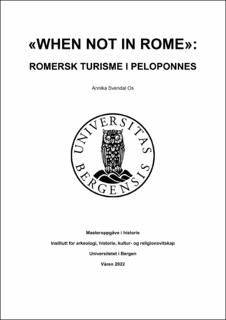| dc.description.abstract | While largely seen as a modern phenomenon, tourism was a big part of the Graeco-Roman world. People traveled to see famous artwork, sculptures and games, to name a few. However, as normal as tourism seems to have been, it has been largely ignored by modern scholarly efforts. This paper aims to shed light on tourism in the ancient world, what socioeconomic functions it served and the different forms it took, using the Peloponnese in Roman times as a way to delve further into the phenomenon. This will be looked into from two angles, from the individual’s standpoint and from a wider, societal level; both from the travelers’ perspective and the places they visited. To do this, different sociological theories will be used; Bourdieu's theory of capital, Hobsbawm’s on invented traditions and Renfrew's theory on peer-polity interaction. Through four case-studies different aspects of ancient tourism will be investigated, first looking at Sparta and the ritual of diamastigosis. A popular tourist attraction in the Roman period, it had no clear Greek predecessor and might have been an example of an invented tradition. The second case looks at Olympia and the many attractions that drove throngs of tourists, both during the games and in the off-season. Keeping to the theme of specific attractions, a particular genre is explored in the third, namely the fossilised remains of prehistoric animals displayed in antiquity as relics of the mythical past. Here we will also see how souvenirs became a lucrative side-income for places as a byproduct of tourism, and how plunder became a way for cities to gain attractions. Lastly we will look into what the Roman general Aemilius Paullus’ tour of Greece can tell us about ancient tourism and more specifically what attracted tourists. Through these case-studies and the different sociological theories ancient tourism is explored. | |
